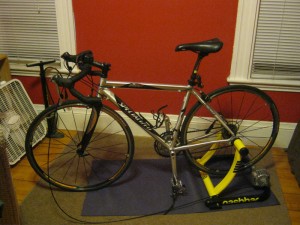I was convinced by a surprise pot hole.
For well over a decade I have commuted by bicycle to and from work at least three days a week even in winter. Of course, in the winter, the sun rises later and sets sooner. The deeper into winter, the darker the commute; the darker the commute, the harder to see the glass, car parts and pot holes that make the ride, shall we say, “challenging.”
Recently I rode the fifteen miles home as the sun gradually set. By the time I was only a few blocks from home, it was dark enough that I could not see much of the road surface even with my bike lights. Coasting down the last big hill I ‘found’ a pot hole – BAM! – flat tire.
As I walked home, I was glad I was close enough not to have to change the tire in darkness. I thought back on the times I had to change a tire at night in the freezing rain or snow. Then I thought about all the near-misses I’ve had with cars over the years, unable to see me no matter how many lights I carried.
The next day I ordered a trainer. A bicycle trainer is basically a bike stand equipped with a mechanical device that creates resistance against the turning of the back wheel of the bicycle. A bit of online study revealed that there are three basic types of trainers, distinguished from each other by their methods of resistance: air resistance trainers, magnetic resistance trainers and fluid resistance trainers. While air trainers seem to have a bit of an edge in terms of realism and magnetic trainers have a price advantage, because I live in a condominium with downstairs neighbors I elected to go with the fluid trainer, which is the quietest. It’s still noisy, but not as.
 On my first ride I found that I could get a good workout on the trainer much faster than I could on the road. On the road there are stop lights and pauses for traffic as well as occasional hills to coast down. On the trainer, the rider controls the resistance either with the gears of the bike or by controlling the resistance level of the trainer. I like to control the resistance by using the gears of the bicycle. To me – a cyclist with many miles in his past – it feels more real.
On my first ride I found that I could get a good workout on the trainer much faster than I could on the road. On the road there are stop lights and pauses for traffic as well as occasional hills to coast down. On the trainer, the rider controls the resistance either with the gears of the bike or by controlling the resistance level of the trainer. I like to control the resistance by using the gears of the bicycle. To me – a cyclist with many miles in his past – it feels more real.
I set up the bike facing the computer so I can put in headphones, put on a TV show, and pedal away. About 15 minutes into a 43-minute vintage, commercial-free TV show I find I’m sweating and my pulse rate is elevated. I have a box fan pointed at me to provide a breeze to keep me cool and my trusty water bottle placed in the bottle cage on my bike to keep me hydrated.
After about a half hour of hard pedaling I find I’m breathing hard, so I shift down and pedal easy for another 5 or 10 minutes. After the ride there will usually be some of the TV show left, so I sit and finish my cool-down period as I watch the end. Before hitting the shower, I round out the workout with some pull-ups, push-ups and sit-ups.
My wife is using it, too. It’s great to hear her pedaling while laughing at old episodes of “Frazier.”
I will enjoy being safe and warm as I get my cycling exercise this winter. For outdoor exercise I’ll go snowshoeing, and I’ll look forward to spring when I can hit the roads safely again.

Tom, this is a really good idea. Now, if you can hook the trainer up to a generator, you can make your own electricity! Why burn calories for nothing?
Great idea, Aya!
The greatest cyclists, Lance Armstrong, for example, can produce about a watt for twenty minutes. Not a lot of power, but enough to power an LCD display during your workout. Many cycles at gyms are so equipped. I wonder if there is a trainer yet… I’ll have to do some research 🙂
Great article Tom! I used to ride a bike up in the mountains years ago, but I prefer walking now that I live in the city. I am just to chicken to ride with drivers on very intense roads. I found a link on how to create a generator with a bike, if anyone is interested: http://www.magnificentrevolution.org/diy/single-bike-generator/
Fantastic! I knew someone must make one. 🙂